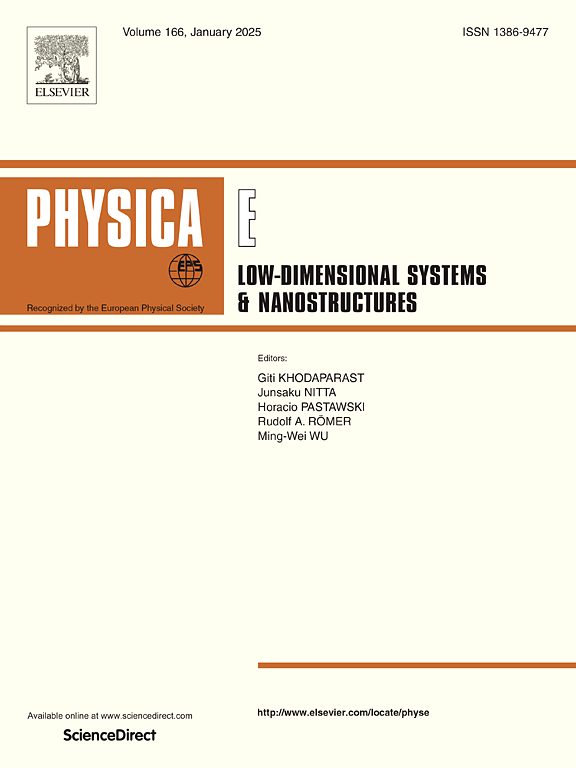利用有限频率散粒噪声探测双量子点系统中Rashba自旋-轨道耦合的大小
IF 2.9
3区 物理与天体物理
Q3 NANOSCIENCE & NANOTECHNOLOGY
Physica E-low-dimensional Systems & Nanostructures
Pub Date : 2024-11-26
DOI:10.1016/j.physe.2024.116159
引用次数: 0
摘要
在耦合量子点(QD)系统中,基于自旋轨道耦合(SOC)的电子自旋自由度的电操纵是基于QD的自旋电子器件的重要研究领域之一。因此,如何定量提取耦合QD系统SOC的大小是一个重要的问题。本文研究了一种具有Rashba SOC的串行耦合双QD系统中电子输运的有限频率散粒噪声。证明了有限频率散粒噪声的波峰和低谷的存在源于双QD系统的量子相干性,波峰和低谷的位置由构成约化密度矩阵非对角元的相干单占本征态的能量本征值之差决定。特别是,当相干单占特征态的能量特征值之差的简并度等于1时,有限频率散点噪声呈现峰值,而简并度等于2时,有限频率散点噪声呈现低谷。此外,电极的自旋极化和qd电极耦合强度对峰和低谷的位置几乎没有影响,但对峰和低谷的宽度和值有一定影响。因此,Rashba SOC的大小和自旋守恒跳变强度可以通过有限频率散粒噪声的峰值和低谷位置来定量确定。本文章由计算机程序翻译,如有差异,请以英文原文为准。
Probing the magnitude of Rashba spin–orbit coupling in a double quantum dot system via finite-frequency shot noise
In the coupled quantum dot (QD) system, the electrical manipulation of spin degree of freedom of electron based on the spin–orbit coupling (SOC) is one of the important research fields for QD-based spintronic devices. Consequently, how to quantitatively extract the magnitude of the SOC of the coupled QD system is an important issue. Here, we study the finite-frequency shot noise of electron transport through a serially coupled double QD system with Rashba SOC. It is demonstrated that the existence of peaks and dips of the finite-frequency shot noise originates from the quantum coherence of the serially coupled double QD system, and the positions of the peaks and dips are determined by the differences between the energy eigenvalues of the coherent singly-occupied eigenstates that forming the off-diagonal elements of the reduced density matrix. In particular, when the degeneracy of the differences between the energy eigenvalues of the coherent singly-occupied eigenstates equals one, the finite-frequency shot noise shows a peak, whereas the degeneracy equals two, the finite-frequency shot noise shows a dip. Moreover, the spin polarization of the electrodes and the QD-electrode coupling strength have almost no influence on the positions of the peaks and dips, but have some influences on the width and values of peaks and dips. Therefore, the magnitude of the Rashba SOC and the spin-conservation hopping strength can be quantitatively determined by the positions of peaks and dips of the finite-frequency shot noise.
求助全文
通过发布文献求助,成功后即可免费获取论文全文。
去求助
来源期刊
CiteScore
7.30
自引率
6.10%
发文量
356
审稿时长
65 days
期刊介绍:
Physica E: Low-dimensional systems and nanostructures contains papers and invited review articles on the fundamental and applied aspects of physics in low-dimensional electron systems, in semiconductor heterostructures, oxide interfaces, quantum wells and superlattices, quantum wires and dots, novel quantum states of matter such as topological insulators, and Weyl semimetals.
Both theoretical and experimental contributions are invited. Topics suitable for publication in this journal include spin related phenomena, optical and transport properties, many-body effects, integer and fractional quantum Hall effects, quantum spin Hall effect, single electron effects and devices, Majorana fermions, and other novel phenomena.
Keywords:
• topological insulators/superconductors, majorana fermions, Wyel semimetals;
• quantum and neuromorphic computing/quantum information physics and devices based on low dimensional systems;
• layered superconductivity, low dimensional systems with superconducting proximity effect;
• 2D materials such as transition metal dichalcogenides;
• oxide heterostructures including ZnO, SrTiO3 etc;
• carbon nanostructures (graphene, carbon nanotubes, diamond NV center, etc.)
• quantum wells and superlattices;
• quantum Hall effect, quantum spin Hall effect, quantum anomalous Hall effect;
• optical- and phonons-related phenomena;
• magnetic-semiconductor structures;
• charge/spin-, magnon-, skyrmion-, Cooper pair- and majorana fermion- transport and tunneling;
• ultra-fast nonlinear optical phenomena;
• novel devices and applications (such as high performance sensor, solar cell, etc);
• novel growth and fabrication techniques for nanostructures

 求助内容:
求助内容: 应助结果提醒方式:
应助结果提醒方式:


